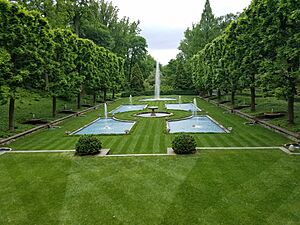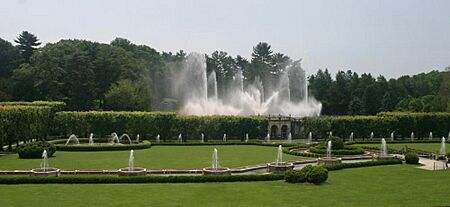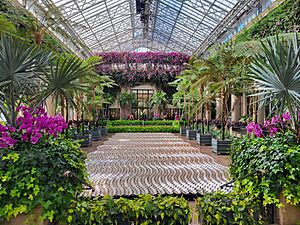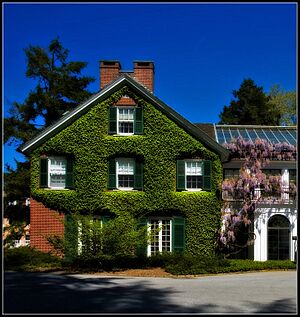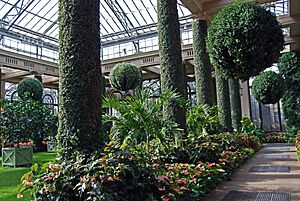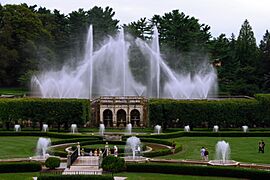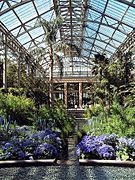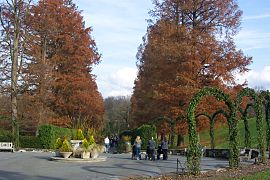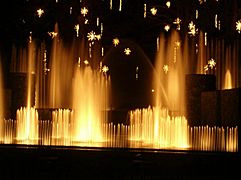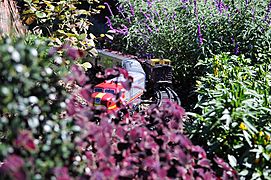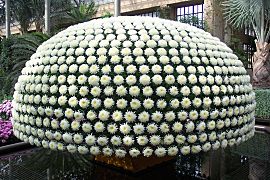Longwood Gardens facts for kids
Quick facts for kids |
|
|
Longwood Gardens
|
|

The Italian Water Garden at Longwood Gardens
|
|
| Location | Kennett Square, Pennsylvania, United States |
|---|---|
| Area | 1,100 acres (450 ha) |
| Visitation | 1.6 million (2023) |
| NRHP reference No. | 72001105 |
| Added to NRHP | December 10, 1972 |
Longwood Gardens is a super cool public garden in Kennett Square, Pennsylvania. It's huge, with over 1,100 acres of beautiful gardens, forests, and open fields. Imagine a giant outdoor museum for plants! It's one of the best gardens in the United States.
You can visit Longwood Gardens all year round. There are amazing plants from all over the world, both inside and outside. They also have fun events, shows, and special attractions for different seasons. You can even learn about plants through classes and workshops.
Contents
A Look Back in Time
Longwood Gardens has a really interesting past. Thousands of years ago, the native Lenape tribe lived here. They fished in the streams, hunted in the forests, and grew crops in the fields. You can even see old spear points from their time at the Peirce-du Pont House.
In 1700, a Quaker farmer named George Peirce bought this land. His family farmed it, and in 1730, his son Joshua built the brick farmhouse that you can still see today.
Later, in 1798, Joshua's grandsons, Samuel and Joshua, started planting an amazing collection of trees. This became an arboretum, which is like a tree museum, covering 15 acres. They gathered trees from nature and from other plant experts.
By the mid-1800s, this arboretum was famous for its trees. It became a popular spot for local people to have picnics and social gatherings. It was even known as a safe place for people escaping slavery before the American Civil War.
But in the early 1900s, the family who owned it lost interest. The beautiful trees were almost cut down for wood! Luckily, a man named Pierre S. du Pont stepped in. On July 20, 1906, he bought the farm to save the trees. He didn't plan to create a huge garden at first. But soon, he wanted to make it a special place to entertain friends. This turned the simple farm into one of the country's best display gardens.
Pierre du Pont opened the garden to everyone in 1921. He made sure it would continue to be a beautiful place for years to come. When he passed away in 1954, he left a plan and money for Longwood to keep growing. For a long time, it was free to visit, but in 1973, they started charging a small fee.
In 2018, Longwood Gardens also took over the historic Longwood Cemetery. This cemetery is right outside the main entrance and has been there since 1855.
What You Can See Today
Today, Longwood Gardens is a massive 1,100-acre wonderland. It has many outdoor gardens, from fancy, formal designs to wild, natural areas. There are also huge indoor gardens under glass, called Conservatories, covering 1.6 acres! These indoor spaces have 13 different gardens and hundreds of plant types, plus fountains.
Longwood also has great learning programs. They even have a free two-year school for people who want to become professional gardeners. They host hundreds of events every year, like flower shows, gardening lessons, and concerts. You can see amazing fountain shows, fireworks, and even a special Christmas light display. During fall and Christmas, there's a cool garden railway with miniature trains.
More than a million people visit Longwood Gardens every year. They are always planning new ways to make the gardens even more amazing for visitors in the future. A big project to update the Main Fountain Garden was finished in 2017.
In 2021, Longwood started an even bigger project called Longwood Reimagined. This project is making the Conservatory and nearby areas even better. By November 2024, new parts opened, including a huge West Conservatory with Mediterranean-style gardens. They also moved a special garden called the Cascade Garden into its own glasshouse. Plus, there's a new outdoor Bonsai Courtyard and a refreshed Waterlily Court.
Outdoor Gardens and Fountains
The idea for Longwood as a public garden started with the Peirce family's tree collection in the 1800s. Joshua and Samuel Peirce planted many different trees in rows near their farmhouse. This area became known as Peirce's Park. Today, visitors still enjoy Peirce's Park, which now has the Sylvan Fountain, added by Pierre S. du Pont in the 1920s.
After Pierre S. du Pont bought the property in 1906, he added more outdoor gardens. In 1907, he created the 600-foot-long Flower Garden Walk. This walk has a pool called the Round Fountain, which was Longwood's very first fountain.
In 1914, inspired by a trip to Italy, Pierre S. du Pont built the Open Air Theatre. It's a beautiful outdoor stage.
From 1925 to 1927, he designed and built the Italian Water Garden. He got the idea from another garden he saw in Italy.
In 1928, du Pont started adding fountains to a garden he had begun in 1921. This area, south of the Conservatory, became his biggest project: the 5-acre Main Fountain Garden. This garden is an engineering marvel, combining fancy Italian designs with French style and amazing technology. The Main Fountain Garden first opened in 1931.
In 1957, the Waterlily Display opened, showing off beautiful waterlilies.
Later, famous landscape designers like Thomas Church and Sir Peter Shepheard helped improve many areas. They designed gardens like the Theatre Garden, Wisteria Garden, and Peony Garden.
In 1995, Peirce's Woods was designed to show off the beauty of the eastern forest. Thousands of native plants were added, some even rescued from highway construction areas!
In 2014, Longwood Gardens opened its new Meadow Garden. This huge 86-acre area shows off native plants and helps wildlife. The historic Webb Farmhouse, from the 1700s, was restored and now helps visitors learn about the meadow.
Also in 2014, the gardens started their biggest project ever: updating the Main Fountain Garden. It reopened on May 27, 2017, looking more spectacular than ever.
In 2021, Longwood started another huge project called Longwood Reimagined. This project is making the Conservatory and surrounding areas even better. New features include a large West Conservatory with Mediterranean-inspired gardens. The special Cascade Garden, designed by Roberto Burle Marx, was moved to its own glasshouse. There's also a new outdoor Bonsai Courtyard and an improved Orchid House.
Other outdoor gardens and features include: Treehouses, the Chimes Tower and Waterfall, the Flower Garden Walk, the Italian Water Garden, and the Topiary Garden.
Longwood also has over 750 acres of natural areas. These include forests, meadows, and wetlands. They work hard to keep these areas healthy and full of native plants and animals.
The Conservatory
Longwood's first indoor garden, or conservatory, was built in 1914. It connected new and old parts of the Peirce farmhouse.
The biggest conservatory, opened in 1921, is home to 4,600 types of plants and trees! It has been expanded and updated many times. The Palm House, a large room for palm trees, opened in 1966. The Silver Garden, designed to look like a dry desert stream, opened in 1989.
In 1992, the Cascade Garden opened. It was designed by a famous Brazilian landscape designer, Roberto Burle Marx. This special garden was moved to its own custom-built glasshouse as part of the Longwood Reimagined project.
In 2007, a much larger Indoor Children's Garden opened in the Conservatory. It's a fun place for kids to explore plants.
In 2010, a huge indoor "green wall" was added. It has 47,000 plants and was the largest green wall in North America when it opened. It even won an award for being America's Best Restroom in 2014!
Main Conservatory gardens include: the Camellia House, East Conservatory, Exhibition Hall, Green Wall, Indoor Children's Garden, Orangery, Orchid House, and Silver Garden.
The Peirce-du Pont House
The Peirce-du Pont House is the oldest building at Longwood Gardens, dating back to 1730. It was the home of the Peirce family for many years. Then, from 1906 until he passed away in 1954, it was Pierre du Pont's weekend home.
Today, you can visit this historic house every day. It's included with your garden admission. The house grew over nearly 200 years, with many additions. Joshua Peirce built the original brick farmhouse in 1730. Later, in 1909 and 1914, Pierre du Pont added more rooms and modern features like plumbing and electricity.
After Pierre du Pont's death, some parts of the house became offices. Many of his belongings went to his family, but his garden books stayed and started Longwood's plant library.
The house now has an exhibit that tells the story of Longwood's history and plants. You can see old photos and learn about the past 300 years of the property.
Amazing Plant Collections
Longwood Gardens has more than 13,500 different kinds of plants! They have special collections that are very important to the garden's mission. Here are some of the cool ones:
- Boxwood: This collection helps keep many different types of boxwood plants safe.
- Chrysanthemum: This collection includes old Asian types of chrysanthemums, some grown in special ways like bonsai. It's one of the biggest collections of its kind.
- Peirce's Trees: These are some of the original trees planted by the Peirce family in the 1800s.
- Waterlily: This collection has many types of waterlilies created by plant breeders in North America.
- Bonsai: The Bonsai Collection started in 1959. It has over 150 tiny trees, carefully shaped and cared for by experts.
- Camellia: This collection focuses on camellias that can grow well in the local area. They even try to create new types that can handle cold weather better.
- Orchids: Pierre S. and Alice du Pont loved orchids! Longwood has over 4,500 orchid plants, with 2,500 different types. You can always see a beautiful display of orchids in the Orchid House.
- US Native Orchids: This collection helps protect rare or endangered native orchids from Pennsylvania and the surrounding region.
- Plants of Conservation Value: This collection includes plants that are rare, threatened, or endangered around the world. Longwood grows them for research and to help save them.
- Water-platter (Victoria): This collection includes giant water-platters. Longwood even created its own special hybrid, the 'Longwood Hybrid', and shares seeds with other gardens to help protect these amazing plants.
Learning at Longwood
Longwood Gardens offers many ways to learn about plants and gardening. They have classes for beginners and for people who want to become professional gardeners. You can learn about landscape design, art, flower arranging, and how to protect nature.
They also have free programs for kids from kindergarten to high school. These programs teach about things like how to care for the environment, plant diversity, and how plants grow. Students can go on guided field trips to explore the gardens.
For older students, Longwood offers internships in many areas, like caring for trees, managing greenhouses, designing displays, and even marketing. They also have a special two-year, tuition-free program for people who want to work in horticulture.
Science and Nature
Since the 1950s, Longwood has been involved in science. They work to understand the natural world, protect different kinds of plants, and find new ways to grow them. They also study how to keep ecosystems healthy and take care of the soil.
Fun Performances
Longwood has always been a place for shows and entertainment. Pierre S. du Pont loved to host parties with music and fireworks in his gardens.
The Open Air Theatre, which opened in 1914, has hosted over 1,500 performances! You can still enjoy summer shows there today. It even has special fountains and a water curtain on stage.
Longwood also uses its other gardens for performances. You might see Indian music in the Italian Water Garden or modern dance in Peirce's Park.
The gardens also have indoor places for shows, like the Ballroom and Exhibition Hall in the Conservatory. The Ballroom, built in 1929, has a beautiful parquet floor and a ceiling with 1,104 rose-colored glass panes. It's still used for concerts and dinners.
The Exhibition Hall has hosted many famous performers. It often has a shallow pool of water to reflect the seasonal plant displays, but it can be drained for events.
The Amazing Organ
Longwood has a huge pipe organ with 10,010 pipes! It was designed by a Belgian musician named Firmin Swinnen. This organ was so big it needed fourteen railway cars to bring all its pipes! It was the largest pipe organ ever put in a private home. Pierre du Pont ordered this massive organ in 1929.
The organ plays into the Ballroom, and you can hear it throughout the Conservatory when certain windows are open. You can even see some of its pipes through glass panels in Longwood's organ museum. The organ was fully restored in 2011. Longwood Gardens also hosts a competition for talented young organ players from around the world.
The Chimes Tower
In 1929, Pierre du Pont built the 61-foot-tall stone Chimes Tower. He bought the biggest set of tower chimes he could find. He even had a switch in his house so he could play them from home!
These chimes were later replaced by an electronic carillon in 1956. Finally, in 2001, a new carillon with 62 cast bells from the Netherlands was installed. Visitors can enjoy live concerts from the carillon in the summer and fall.
Seasonal Fun
Longwood Gardens has special themes throughout the year, making each visit unique!
- Winter Wonder: Starts in mid-January.
- Spring Blooms: Starts in early April.
- Festival of Fountains: Runs from early May through October.
- Autumn's Colors: Starts in early September and ends with the Chrysanthemum festival.
- A Longwood Christmas: Starts before Thanksgiving and finishes the first week of January.
Gallery
See also
 In Spanish: Longwood Gardens para niños
In Spanish: Longwood Gardens para niños



